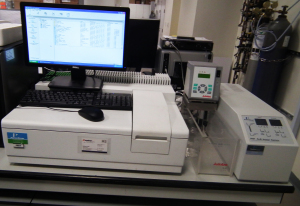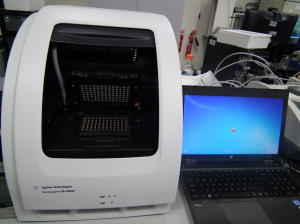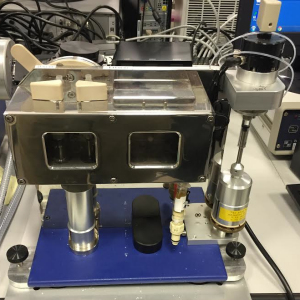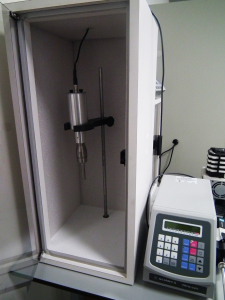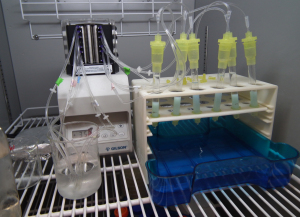(+) Differential Scanning Calorimetry (DSC)
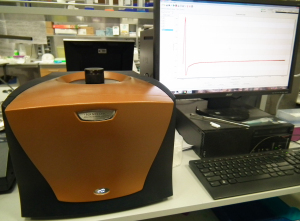
The Nano DSC, from TA Instruments, measures the amount of heat absorbed or released upon the unfolding of proteins at specific temperature as the sample is heated. The temperature difference between the sample and the reference cell represent the heat of unfolding for the protein that can be used directly to measure the energetic of unfolding of the protein. The more intrinsically stable the protein, the higher the melting temperature of the unfolding transition. DSC can be used to compare the thermodynamic stability of different proteins, e.g. wild-type and mutant proteins, or protein in the presence of different substrate, products, inhibitors, or transition-state analogs. The difference in thermodynamic stability represents the characteristics of the different proteins or different conformations of the same protein.
(+) Isothermal Titration Calorimetry (ITC)

The Nano ITC, from TA Instruments, measures the heat released or absorbed during a biomolecular binding event to determine the binding constants (KB), reaction stoichiometry (n), enthalpy (ΔH) and entropy (ΔS). These measurements will provide a complete thermodynamic characterization of the molecular interaction between the two molecules. ITC is a very effective tool that can be used in the design and development of new and effective pharmaceutical compounds.
(+) FPLC System
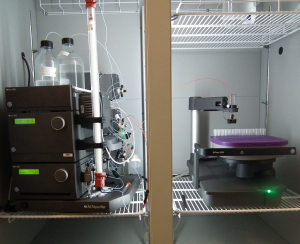
The ÄKTA explorer 100 Air, from GE Healthcare Life Sciences, is a Fast-performance liquid chromatography (FPLC) system that allows the purification of macromolecules using high and low-throughput applications. It is designed for scouting, development, and optimization of methods for all chromatographic techniques by accommodating different columns for different applications and its hardware and software will allow automation of sample applications.
(+) UV-vis Absorption Spectrometer
(+) Real-Time PCR
(+) Circular Dichroism (CD) Spectrometer
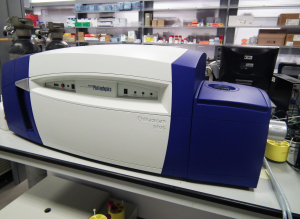
Chirascan-plus from Applied Photophysics is a circular dichroism (CD) spectrometer with fast scanning rate and high sensitivity. It can be used for direct probing of the protein’s secondary structure or conformational changes upon binding or interactions with substrate, products, or inhibitors. Thermal ramping capabilities of the Chirascan allow for the calculation of thermodynamic parameters that affect the protein stability, where the protein’s CD spectra are collected as function of temperature. We use CD to confirm the protein’s structural fold and determine its thermal and kinetic stabilities.
(+) Stopped-Flow CD Spectroscopy
(+) Stopped-Flow Spectrometer
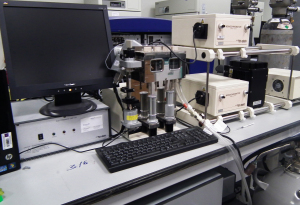
Stopped-flow is a spectroscopic technique used for studying fast reaction mechanisms in solution over timescales of about 1ms up to 100’s seconds. In general, two reagents are rapidly mixed together and then ‘stopped’ in an observation cell. The sample cell is irradiated with (usually) monochromatic light and as the reaction proceeds the change in the recorded signal, usually a fluorescence signal or the absorbance at a specific wavelength, is recorded as a function of time. Analysis of the resulting kinetic transient can determine reaction rates, complexity of the reaction mechanism, information on short-lived reaction intermediates etc. A series of stopped-flow experiments can be used to show the effect of parameters such as temperature, pH and reagent concentration on the kinetics of the reaction.
(+) Sonicator
(+) Protein Purification Setup
(+) Bravo Automated Liquid Handling Platform from Agilent
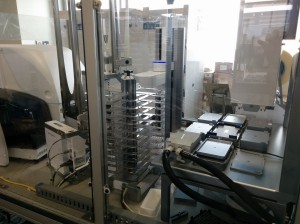
Bravo Automated Liquid Handling Platform from Agilent Technologies is fastest and versatile liquid-handling system that provides speed and precision to liquid handling. The robot is utilized in high-throughput experimental analysis, screening for new lead compounds as therapeutical targets, and to set up custom protein crystallization screens.
(+) HoneyBee Microarrayer for Protein Crystallography from Digilab
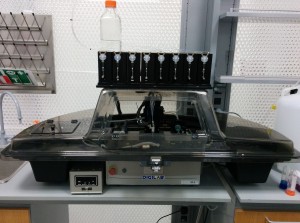
Digilab HoneyBee X8 is a high speed bench-top protein crystallization system with 8 synQUAD dispense channels. The robot supports all commercial plate formats for the miniaturization of vapor diffusion and micro-batch protein crystallization experiments including the MRC 96-well sitting drop crystallization plate from molecular dimensions. Fast and accurate dispensing of nanoliter volumes is achieved using synQUAD™ dispensers with high resolution syringe pumps. The Honeybee robotic system is used for high-throughput crystallization screening of optimum conditions to acquire protein crystals that will be used to collect X-ray data to solve the protein’s 3D structure.

